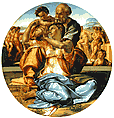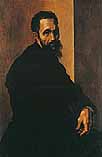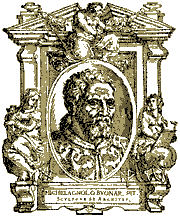Painter, sculptor, architect and poet
Caprese 1475-Rome 1564
The complete artist, he expressed the ideas of the Renaissance,
passing from "realism" to the "beautiful" as the quintessence
and glorification of the capacity of man.
After completing his humanistic studies, he started work in Ghirlandaio's
workshop in Florence while still only a youth (1488); his interest in ancient
sculpture soon led him to frequent the garden at Saint
Mark, where the Medici family had already put together a sizeable collection
of classical statuary. His first attempts at sculpture were noticed by Lorenzo
dei Medici, who took Michelangelo to live with his family in his house in Via
Larga (now Via Cavour), where he was in close contact with the circle of political
and cultural personalities (like Poliziano) that gravitated around the court.
Michelangelo was to be a protégé of the Medici family for the rest
of his life, even when he fought against them during the famous siege of Florence
in 1530.

Uffizi - Doni Tondo
The Battle of the Centaurs and the Madonna of the Stairs (1490-92 Museum
of Casa Buonarroti), where the transition between the 15th century and
classicism can clearly be seen, date from this early period. He fled
from Florence in 1494 to escape Charles VIII and went to Bologna where,
after seeing the reliefs by Jacopo della Quercia, he sculpted a bas-relief
for the Duomo of San Petronio.
He returned to Florence in 1495 and - in the same period in which Savonarola
was preaching against luxury and pagan art - he created the Drunken Bacchus (Bargello).
Then he went to Rome where he sculpted the famous Vatican Pietà. He came
back to Florence between 1501 and 1505 and, at the suggestion of Leonardo, proceeded
to carry out a series of masterpieces: the Doni Tondo (Uffizi), the Pitti Tondo
(Bargello), the lost cartoon for the fresco of the Battle of Cascina and the
marble statue of David (Galleria dell'Accademia), which was placed outside the
entrance to Palazzo Vecchio as a symbol of the
Second Republic as well as of the Renaissance ideals of
free men and masters of fate.

Michelangelo - Portrait
On Michelangelo's return to Rome, Pope Julius II gave him a commission
that was to weigh heavily on him for over forty years: the monumental
tomb of the Pope, conceived as a typical classical mausoleum that united
sculpture and painting. Michelangelo spent eight months in Carrara to
choose the most suitable marble but by then the Pope was more interested
in the project of St. Peter's Church, which had been entrusted to Bramante,
so that Michelangelo, disappointed and jealous, left Rome and went for
a short period to Florence and then Bologna, where he was later to make
his peace with the Pontiff.
In 1508 the Pope gave him an extremely important task to carry out: the decoration
of the ceiling of the Sistine Chapel. The five hundred square metre area was
decorated by this man in four years of very hard work and this Neoplatonic interpretation
of the Book of Genesis fully expresses the artistic ideals of the Renaissance.
Julius II died in 1513 which brought the problem of his tomb up again: the second
commission led to the creation of the Moses and the two Slaves in the Louvre
but again it all came to nothing.

New Sacristy of St. Lorenzo
In the years that followed he worked on the Basilica of San Lorenzo
in Florence, again under Medici patronage, first on the design for the
facade (1516, later interrupted) and then on the construction of the
New Sacristy (1520-34) - opposite the Old Sacristy by Brunelleschi -,
with the tombs of Giuliano Duke of Nemours and Lorenzo Duke of Urbino.
Here the rules of composition and the sense of space of Humanism are
placed in discussion and the dialectic relationship between the architectural
elements already expresses the Mannerist doubts. Last of all, again at
San Lorenzo, he worked on the project for the Laurentian Library (1524,
but not completed until late in the century with the collaboration of
Ammannati)), a real bridge between the high Renaissance and the Baroque style.
Between 1527 (the Sack of Rome) and 1530 (the siege of Florence), Michelangelo
worked for the Florentine Republic directing the
building of the fortifications but, with the fall of the city to Clement VII,
he went back to work for the Medici family. He resumed his work for the tomb
of Julius II and sculpted the four unfinished Captives Academy.
Nor were these to decorate the tomb of the Pope, whose final version - much of
it carried out by Michelangelo's assistants - was not complete until 1545 when
it was placed in St. Pietro in Vincoli.
His father died in 1534 and Michelangelo left Florence forever. He then accepted
a commission from Clement VII to fresco the wall behind the altar in the Sistine
Chapel with the Last Judgement (1536-41). The final act of the life of man is
shown here as a cosmic tragedy;
classical iconography and perspective are completely upset and we
find the intellectual and moral security that had given the Renaissance
its solid basis disappearing alongside its formal ideals. In their
place we find a suffering and desperate human race, terrified at
the thought of being condemned: this vision was almost certainly
formed among the Roman spiritual circles that the artist frequented
with Vittoria Colonna and which were fighting for a reform of the
Church.

Pietà -
Museum of Opera
del Duomo
Michelangelo spent the last twenty years of his life working in the
field of architecture: he completed the construction of the Laurentian
Library in Florence, designed Piazza del Campidoglio and, modifying the
project of Bramante, built the Cupola of St. Peter's in Rome.
His last sculptures, carried out between 1547 and 1555, developed the subject
of the Pietà: the Palestrina Pietà (Academy), the Pietà in the Duomo di Firenze (Museum
of Opera del Duomo), the Pietà Rondanini (Milan, Castello Sforzesco).
Although when he died - after having been almost forced to be the artist of several
Popes - his mortal remains were claimed by the city of Florence, they were eventually
removed from Rome by his nephew in secret.

